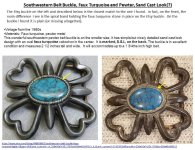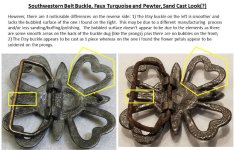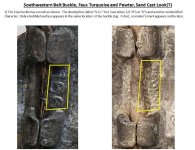invent4hir
Bronze Member
- Aug 1, 2017
- 1,785
- 2,733
- 🏆 Honorable Mentions:
- 3
- Detector(s) used
- Whites V3i & DFX
- Primary Interest:
- All Treasure Hunting
This belt buckle was found partially buried behind a barn. The present owner, who has lived there more than 30 years, said they had never seen it before. I found a similar buckle on Etsy that claims to be from the 1980s. It is shown on the left in the pictures. However, the construction of mine appears different as seen on the right. Also it lacks markings. I tested for silver (with bleach) and the result was negative. Given the amount of scale on it when first found – it reminds me of pewter or pot/white metal. Also I believe the stone to be faux turquoise.
Answers to the questions below will help me write an accurate description to accompany the buckle in an educational display case to be donated to the local historical society.
1. What is the approximate date range of when the buckle was manufactured and why?
2. Since no maker’s mark was found is there any way to determine if it was from an Indian trading post? If so, how?
Answers to the questions below will help me write an accurate description to accompany the buckle in an educational display case to be donated to the local historical society.
1. What is the approximate date range of when the buckle was manufactured and why?
2. Since no maker’s mark was found is there any way to determine if it was from an Indian trading post? If so, how?








